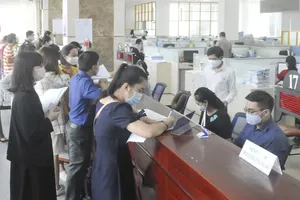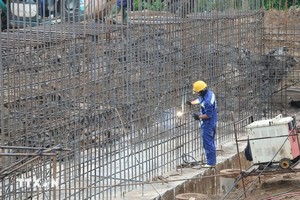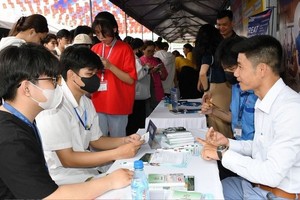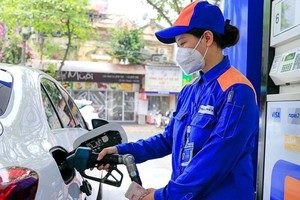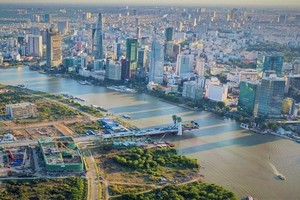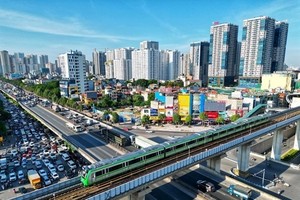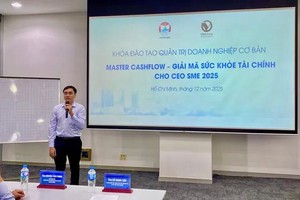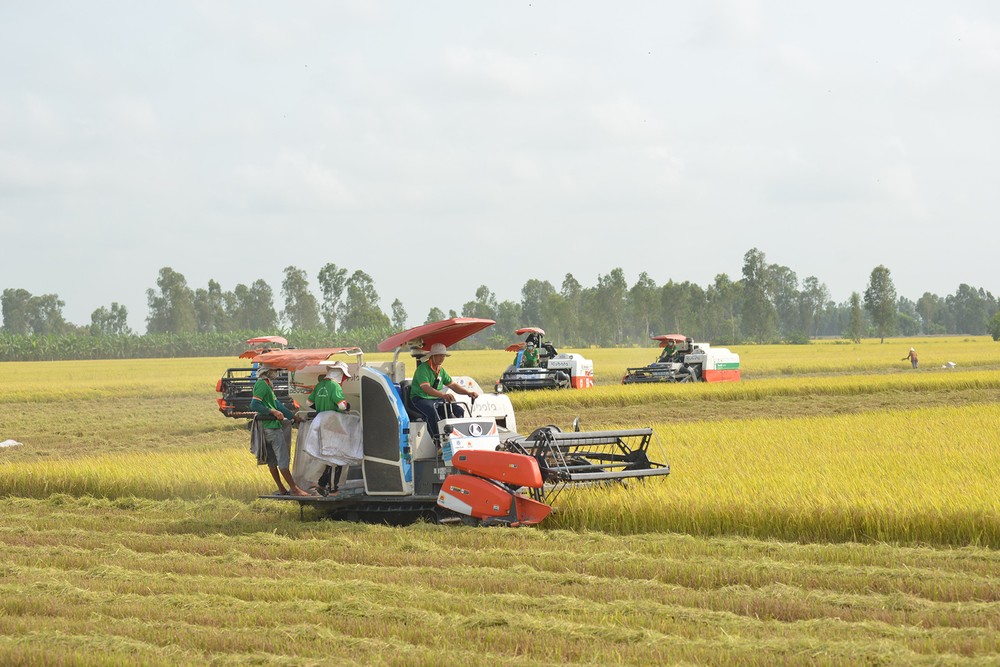
This region boasts a complex network of rivers and canals, abundant fruit orchards, expansive mangrove forests, recognized biosphere reserves, national parks, and nature reserves.
Vietnamese rice exported to 27 countries, territories
According to the Ministry of Agriculture and Rural Development (MARD), the Mekong Delta region supplies approximately 23 million tons of rice annually. Additionally, the total output of main fruit crops such as mangoes, bananas, dragon fruit, pineapples, oranges, tangerines, pomelos, longans, rambutans, durians, and jackfruits in the region reaches nearly 5.5 million tons per year. Overall, the Mekong Delta region currently contributes over 31 percent to the total GDP of the agricultural sector.
Mr. Tran Quoc Toan, Deputy Director of the Vietnam Trade Promotion Agency under the Ministry of Industry and Trade, said that in 2023, Vietnamese rice products met consumer demand in 27 countries and territories. Rice export volume set a new record in 2023, reaching over 8.3 million tons, equivalent to US$4.7 billion, marking a 35.5 percent increase compared to 2022. This figure is expected to be the same or even higher in 2024.
"Various Vietnamese goods, including rice, cashews, coffee, and pepper, are now available in South Africa. Notably, rice exports surpassed $6 million for the first time, in 2023. This solidifies Vietnam's crucial role as a key food supplier in this country and the globe," emphasized Mr. Pham Thanh Hai, First Secretary at the Vietnam Trade Office in South Africa.
The Mekong Delta is also a significant source of seafood supply for numerous countries worldwide. Mr. Truong Dinh Hoe, General Secretary of the Vietnam Association of Seafood Exporters and Producers, reported that from the beginning of this year until now, Vietnam has exported a substantial volume of shrimp, pangasius fish, tuna, octopus, blue crab, and other aquatic products, totaling $2 billion in value, to various countries globally. Shrimp leads the exports with nearly $700 million, followed by pangasius fish with almost $500 million, alongside various other seafood and mollusks. The top five importers of Vietnamese seafood are the United States, Japan, Europe, South Korea, and Australia.
According to Hoe, the five localities with the highest aquaculture production supplying the global market in the Mekong Delta region include Ca Mau, Bac Lieu, Kien Giang, Tra Vinh, and Ben Tre.
The safe "hub" of the food supply chain
Vietnamese products have exerted and continue to significantly influence global consumer demand. A recent study by Oxford Economics has disclosed that Vietnam ranks among the top five major food suppliers worldwide. Moreover, the country commands a 15 percent market share in global rice production supply.
Since 2023, numerous global distribution conglomerates have set up offices in the Southern region to source goods from this area. Mr. Nguyen Duc Trong, in charge of new supplier development at Walmart Vietnam, mentioned that the conglomerate has established a procurement hub in Vietnam. The group has partnered with the Ministry of Industry and Trade to work with enterprises, farmers, and cooperatives in the Mekong Delta region to procure products such as Hoa Loc mangoes, pomelos, star apples, and durians.
It is noteworthy that Vietnam ranks among the top five countries supplying the highest volume of goods to Walmart, estimated at around $7 billion annually. The demand for Vietnamese fruits, as well as agricultural and food products with distinctive Vietnamese characteristics, has been on the rise in markets where Walmart operates.
Adding to this discussion, Mr. Yuichiro Shiotani, Director of Aeon Topvalu Vietnam, shared that in recent years, the procurement volume of agricultural and aquatic products in Vietnam has doubled compared to previous years, with an expected value of $1 billion by 2025. Starting from 2024, alongside its subsidiary companies sourcing goods in Vietnam, the conglomerate will introduce more subsidiaries from other countries to explore and establish bases, thereby increasing Vietnam's goods procurement ratio.
Mr. Mirash Basheer, representative of Lulu Group - a top goods distribution chain in the Middle East market, disclosed their intention to source Halal-certified products from Vietnam. Vietnam has become one of the world's major exporters of agricultural and aquatic products, featuring prominent items like rice, rubber, tea, cashews, coffee, pepper, shrimp, and fish, and has crucial advantages. Additionally, Vietnam's geographical location is strategically advantageous, close to significant Halal markets, as around 62 percent of the Muslim population resides in Asia.
Mr. PHUNG VAN THANH, Trade Counselor at the Vietnamese Embassy in the Philippines: Vietnam is the Philippines' primary rice supplier
Despite being a rice-producing nation with an average output of around 13 million tons per year, the Philippines still faces a shortfall in meeting its consumption demand of approximately 17 million tons annually. This necessitates additional rice imports from other countries. Currently, Vietnam is the largest exporter of rice to the Philippines, accounting for approximately 85 percent of its total rice imports, with an estimated volume of about 3.2 million tons. This figure is projected to increase to 3.7 million tons by 2024.
Recently, a delegation from the Philippine Government visited Vietnam to discuss and sign a memorandum of understanding on increasing the food supply, especially rice, to the Philippines. This underscores Vietnam's vital role as a significant rice exporting partner for the Philippines, ensuring food security for its citizens and the nation. The remaining challenge is for Vietnam, particularly the Mekong Delta, to provide a variety of rice types at different price points to meet the diverse needs and purchasing power of this market.
Mr. TRAN PHU LU, Director of the Investment & Trade Promotion Center of Ho Chi Minh City: Opportunities for export expansion
Vietnam's agricultural sector has been seeing numerous new export opportunities. Firstly, Vietnam can leverage its export potential in major markets such as the United States, Europe, China, and Japan, owing to the diversity and high quality of products such as coffee, rice, and cashews.
Participating in free trade agreements also facilitates tariff reduction and enhances competitiveness for Vietnamese products, thereby increasing export market share. Moreover, the development of digital technology opens up opportunities for Vietnamese businesses to optimize the agricultural value chain through online platforms and international connectivity.
However, Vietnam also faces challenges in the near future. While joining free trade agreements will attract foreign direct investment, it will also create competitive pressure from foreign businesses on domestic enterprises.
Furthermore, consumer attitudes have shifted, with an increasing preference for environmentally friendly products. Consequently, to meet this demand, efforts must be made by farmers, manufacturers, and retailers to invest in transitioning production and business models towards sustainable development.
The Mekong Delta, also known as the Southwest region, encompasses 13 provinces and municipalities in the southernmost part of the country. It borders the Southeast region, notably Ho Chi Minh City - the economic center of Vietnam. To the North, it adjoins Cambodia, while the Gulf of Thailand lies to the Southwest and the East Sea to the Southeast. Covering a natural area of nearly 40,000 square kilometers, this region is home to nearly 18 million people.
